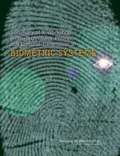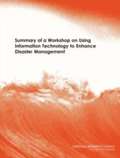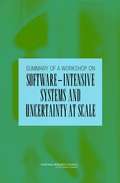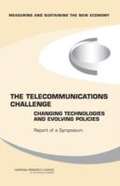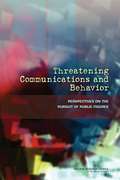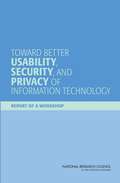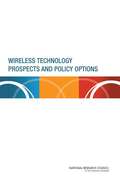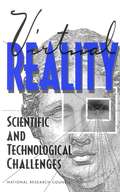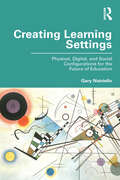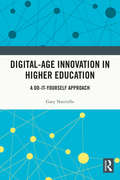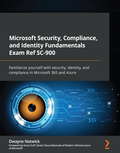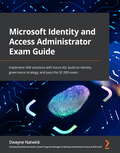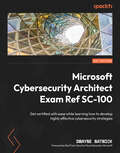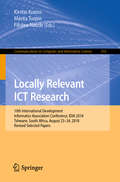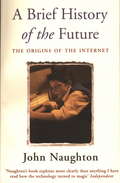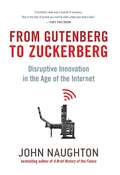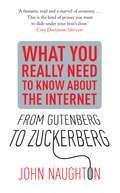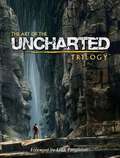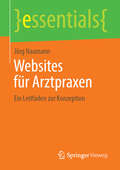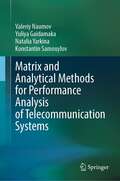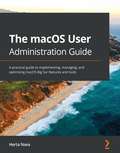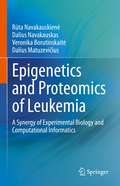- Table View
- List View
Summary of a Workshop on the Technology, Policy, and Cultural Dimensions of Biometric Systems
by National Research Council of the National AcademiesBiometrics—the use of physiological and behavioral characteristics for identification purposes—has been promoted as a way to enhance security and identification efficiency. There are questions, however, about, among other issues, the effectiveness of biometric security measures, usability, and the social impacts of biometric technologies. To address these and other important questions, the NRC was asked by DARPA, the DHS, and the CIA to undertake a comprehensive assessment of biometrics that examines current capabilities, future possibilities, and the role of the government in their developments. As a first step, a workshop was held at which a variety of views about biometric technologies and systems were presented. This report presents a summary of the workshop’s five panels: scientific and technical challenges; measurement, statistics, testing, and evaluation; legislative, policy, human, and cultural factors; scenarios and applications; and technical and policy aspects of information sharing. The results of this workshop coupled with other information will form the basis of the study’s final report.
Summary of a Workshop on Using Information Technology to Enhance Disaster Management
by National Research Council of the National AcademiesThe National Academies Press (NAP)--publisher for the National Academies--publishes more than 200 books a year offering the most authoritative views, definitive information, and groundbreaking recommendations on a wide range of topics in science, engineering, and health. Our books are unique in that they are authored by the nation's leading experts in every scientific field.
Summary Of A Workshop On Software-intensive Systems And Uncertainty At Scale
by National Research Council of the National AcademiesThe growing scale and complexity of software-intensive systems are introducing fundamental new challenges of uncertainty and scale that are particularly demanding for defense systems. To assist in meeting these challenges, the Department of Defense asked the NRC to assess the nature of U.S. national investment in software research. As part of this study, a workshop was held to examine uncertainty at scale in current and future software-intensive systems. This report presents a summary of the workshop discussions that centered on process, architecture, and the grand scale; DoD software challenges for future systems; agility at scale; quality and assurance with scale and uncertainty; and enterprise scale and beyond. The report also offers a summary of key themes emerging from the workshop: architectural challenges in large-scale systems; the need for software engineering capability; and open questions and research opportunities.
The Telecommunications Challenge: Changing Technologies And Evolving Policies
by National Research Council of the National AcademiesStarting in the mid 1990s, the United States economy experienced an unprecedented upsurge in economic productivity. Rapid technological change in communications, computing, and information management continue to promise further gains in productivity, a phenomenon often referred to as the New Economy. To better understand the sources of these gains and the policy measures needed to sustain these positive trends, the National Academies Board on Science, Technology, and Economic Policy (STEP) convened a series of workshops and commissioned papers on Measuring and Sustaining the New Economy. This workshop, entitled “The Telecommunications Challenge: Changing Technologies and Evolving Policies,” brought together leading industry representatives and government officials to discuss issues generated by the rapid technological change occurring in the telecommunications industry and the regulatory and policy challenges this creates. The workshop presented a variety of perspectives relating to developments in the telecommunications industry such as the potential of and impediments to broadband technology.
Threatening Communications and Behavior: Perspectives on the Pursuit of Public Figures
by National Research Council of the National AcademiesToday's world of rapid social, technological, and behavioral change provides new opportunities for communications with few limitations of time and space. Through these communications, people leave behind an ever-growing collection of traces of their daily activities, including digital footprints provided by text, voice, and other modes of communication. Meanwhile, new techniques for aggregating and evaluating diverse and multimodal information sources are available to security services that must reliably identify communications indicating a high likelihood of future violence. In the context of this changed and changing world of communications and behavior, the Board on Behavioral, Cognitive, and Sensory Sciences of the National Research Council presents this volume of three papers as one portion of the vast subject of threatening communications and behavior. The papers review the behavioral and social sciences research on the likelihood that someone who engages in abnormal and/or threatening communications will actually then try to do harm. The focus is on how the scientific knowledge can inform and advance future research on threat assessments, in part by considering the approaches and techniques used to analyze communications and behavior in the dynamic context of today's world. The papers in the collection were written within the context of protecting high-profile public figures from potential attach or harm. The research, however, is broadly applicable to U.S. national security including potential applications for analysis of communications from leaders of hostile nations and public threats from terrorist groups. This work highlights the complex psychology of threatening communications and behavior, and it offers knowledge and perspectives from multiple domains that contribute to a deeper understanding of the value of communications in predicting and preventing violent behaviors.
Toward Better Usability, Security, and Privacy of Information Technology: Report of a Workshop
by National Research Council of the National AcademiesDespite many advances, security and privacy often remain too complex for individuals or enterprises to manage effectively or to use conveniently. Security is hard for users, administrators, and developers to understand, making it all too easy to use, configure, or operate systems in ways that are inadvertently insecure. Moreover, security and privacy technologies originally were developed in a context in which system administrators had primary responsibility for security and privacy protections and in which the users tended to be sophisticated. Today, the user base is much wider--including the vast majority of employees in many organizations and a large fraction of households--but the basic models for security and privacy are essentially unchanged.Security features can be clumsy and awkward to use and can present significant obstacles to getting work done. As a result, cybersecurity measures are all too often disabled or bypassed by the users they are intended to protect. Similarly, when security gets in the way of functionality, designers and administrators deemphasize it. The result is that end users often engage in actions, knowingly or unknowingly, that compromise the security of computer systems or contribute to the unwanted release of personal or other confidential information. <i>Toward Better Usability, Security, and Privacy of Information Technology</i> discusses computer system security and privacy, their relationship to usability, and research at their intersection.
Wireless Technology Prospects and Policy Options
by National Research Council of the National AcademiesThe use of radio-frequency communication--commonly referred to as wireless communication--is becoming more pervasive as well as more economically and socially important. Technological progress over many decades has enabled the deployment of several successive generations of cellular telephone technology, which is now used by many billions of people worldwide; the near-universal addition of wireless local area networking to personal computers; and a proliferation of actual and proposed uses of wireless communications. The flood of new technologies, applications, and markets has also opened up opportunities for examining and adjusting the policy framework that currently governs the management and use of the spectrum and the institutions involved in it, and models for allocating spectrum and charging for it have come under increasing scrutiny. Yet even as many agree that further change to the policy framework is needed, there is debate about precisely how the overall framework should be changed, what trajectory its evolution should follow, and how dramatic or rapid the change should be. Many groups have opinions, positions, demands, and desires related to these questions--reflecting multiple commercial, social, and political agendas and a mix of technical, economic, and social perspectives. The development of technologies and associated policy and regulatory regimes are often closely coupled, an interplay apparent as early as the 1910s, when spectrum policy emerged in response to the growth of radio communications. As outlined in this report, current and ongoing technological advances suggest the need for a careful reassessment of the assumptions that inform spectrum policy in the United States today. This book seeks to shine a spotlight on 21st-century technology trends and to outline the implications of emerging technologies for spectrum management in ways that the committee hopes will be useful to those setting future spectrum policy.
Virtual Reality: Scientific and Technological Challenges
by National Research Council StaffDespite widespread interest in virtual reality, research and development efforts in synthetic environments (SE)--the field encompassing virtual environments, teleoperation, and hybrids--have remained fragmented.Virtual Reality is the first integrated treatment of the topic, presenting current knowledge along with thought-provoking vignettes about a future where SE is commonplace.This volume discusses all aspects of creating a system that will allow human operators to see, hear, smell, taste, move about, give commands, respond to conditions, and manipulate objects effectively in a real or virtual environment. The committee of computer scientists, engineers, and psychologists on the leading edge of SE development explores the potential applications of SE in the areas of manufacturing, medicine, education, training, scientific visualization, and teleoperation in hazardous environments.The committee also offers recommendations for development of improved SE technology, needed studies of human behavior and evaluation of SE systems, and government policy and infrastructure.
Creating Learning Settings: Physical, Digital, and Social Configurations for the Future of Education
by Gary NatrielloCreating Learning Settings examines the design and implementation of learning settings informed by the newest, most expansive insights into how people learn in the post-industrial age. Educators today are tasked with moving beyond the fixed, traditional practices that have long dominated formal schooling and becoming more dynamic and strategic in arranging learners, facilitators, resources, on-site and virtual environments, and learning experiences. Integrating contemporary theoretical approaches and empirical studies, this book offers a systematic approach to creating settings that leverage the physical, digital, resource, and social dimensions necessary to support learning.
Digital-Age Innovation in Higher Education: A Do-It-Yourself Approach
by Gary NatrielloDigital-Age Innovation in Higher Education recounts the creation, development, and growth of an innovation unit within a major university. This single case study follows the development of the EdLab at the Gottesman Libraries of Teachers College, Columbia University, which was charged with developing new services and products at a time when digital technologies were markedly beginning to impact the sector. The major steps taken – recruiting staff in key skill areas, developing projects, collaborating across organizational lines, securing resources, delivering new services, and more – are covered in detail, illustrating the opportunities and challenges presented by innovation mandates in long-established organizations with stable operations and traditional academic values and practices.
Microsoft Security, Compliance, and Identity Fundamentals Exam Ref SC-900: Familiarize yourself with security, identity, and compliance in Microsoft 365 and Azure
by Dwayne Natwick Sonia CuffUnderstand the fundamentals of security, compliance, and identity solutions across Microsoft Azure, Microsoft 365, and related cloud-based Microsoft servicesKey FeaturesGrasp Azure AD services and identity principles, secure authentication, and access managementUnderstand threat protection with Microsoft 365 Defender and Microsoft Defender for Cloud security managementLearn about security capabilities in Microsoft Sentinel, Microsoft 365 Defender, and Microsoft IntuneBook DescriptionCloud technologies have made building a defense-in-depth security strategy of paramount importance. Without proper planning and discipline in deploying the security posture across Microsoft 365 and Azure, you are compromising your infrastructure and data. Microsoft Security, Compliance, and Identity Fundamentals is a comprehensive guide that covers all of the exam objectives for the SC-900 exam while walking you through the core security services available for Microsoft 365 and Azure.This book starts by simplifying the concepts of security, compliance, and identity before helping you get to grips with Azure Active Directory, covering the capabilities of Microsoft's identity and access management (IAM) solutions. You'll then advance to compliance center, information protection, and governance in Microsoft 365. You'll find out all you need to know about the services available within Azure and Microsoft 365 for building a defense-in-depth security posture, and finally become familiar with Microsoft's compliance monitoring capabilities.By the end of the book, you'll have gained the knowledge you need to take the SC-900 certification exam and implement solutions in real-life scenarios.What you will learnBecome well-versed with security, compliance, and identity principlesExplore the authentication, access control, and identity management capabilities of Azure Active DirectoryUnderstand the identity protection and governance aspects of Azure and Microsoft 365Get to grips with the basic security capabilities for networks, VMs, and dataDiscover security management through Microsoft Defender for CloudWork with Microsoft Sentinel and Microsoft 365 DefenderDeal with compliance, governance, and risk in Microsoft 365 and AzureWho this book is forThis book is for cloud security engineers, Microsoft 365 administrators, Azure administrators, and anyone in between who wants to get up to speed with the security, compliance, and identity fundamentals to achieve the SC-900 certification. A basic understanding of the fundamental services within Microsoft 365 and Azure will be helpful but not essential.
Microsoft Identity and Access Administrator Exam Guide: Implement IAM solutions with Azure AD, build an identity governance strategy, and pass the SC-300 exam
by Dwayne Natwick Shannon KuehnThis certification guide focuses on identity solutions and strategies that will help you prepare for Microsoft Identity and Access Administrator certification, while enabling you to implement what you've learned in real-world scenariosKey FeaturesDesign, implement, and operate identity and access management systems using Azure ADProvide secure authentication and authorization access to enterprise applicationsImplement access and authentication for cloud-only and hybrid infrastructuresBook DescriptionCloud technologies have made identity and access the new control plane for securing data. Without proper planning and discipline in deploying, monitoring, and managing identity and access for users, administrators, and guests, you may be compromising your infrastructure and data. This book is a preparation guide that covers all the objectives of the SC-300 exam, while teaching you about the identity and access services that are available from Microsoft and preparing you for real-world challenges.The book starts with an overview of the SC-300 exam and helps you understand identity and access management. As you progress to the implementation of IAM solutions, you'll learn to deploy secure identity and access within Microsoft 365 and Azure Active Directory. The book will take you from legacy on-premises identity solutions to modern and password-less authentication solutions that provide high-level security for identity and access. You'll focus on implementing access and authentication for cloud-only and hybrid infrastructures as well as understand how to protect them using the principles of zero trust. The book also features mock tests toward the end to help you prepare effectively for the exam.By the end of this book, you'll have learned how to plan, deploy, and manage identity and access solutions for Microsoft and hybrid infrastructures.What you will learnUnderstand core exam objectives to pass the SC-300 examImplement an identity management solution with MS Azure ADManage identity with multi-factor authentication (MFA), conditional access, and identity protectionDesign, implement, and monitor the integration of enterprise apps for Single Sign-On (SSO)Add apps to your identity and access solution with app registrationDesign and implement identity governance for your identity solutionWho this book is forThis book is for cloud security engineers, Microsoft 365 administrators, Microsoft 365 users, Microsoft 365 identity administrators, and anyone who wants to learn identity and access management and gain SC-300 certification. You should have a basic understanding of the fundamental services within Microsoft 365 and Azure Active Directory before getting started with this Microsoft book.
Microsoft Cybersecurity Architect Exam Ref SC-100: Get certified with ease while learning how to develop highly effective cybersecurity strategies
by Dwayne Natwick Rod TrentAdvance your knowledge of architecting and evaluating cybersecurity services to tackle day-to-day challengesKey FeaturesGain a deep understanding of all topics covered in the SC-100 examBenefit from practical examples that will help you put your new knowledge to workDesign a zero-trust architecture and strategies for data, applications, access management, identity, and infrastructureBook DescriptionMicrosoft Cybersecurity Architect Exam Ref SC-100 is a comprehensive guide that will help cybersecurity professionals design and evaluate the cybersecurity architecture of Microsoft cloud services. Complete with hands-on tutorials, projects, and self-assessment questions, you'll have everything you need to pass the SC-100 exam. This book will take you through designing a strategy for a cybersecurity architecture and evaluating the governance, risk, and compliance (GRC) of the architecture. This will include cloud-only and hybrid infrastructures, where you'll learn how to protect using the principles of zero trust, along with evaluating security operations and the overall security posture. To make sure that you are able to take the SC-100 exam with confidence, the last chapter of this book will let you test your knowledge with a mock exam and practice questions. By the end of this book, you'll have the knowledge you need to plan, design, and evaluate cybersecurity for Microsoft cloud and hybrid infrastructures, and pass the SC-100 exam with flying colors.What you will learnDesign a zero-trust strategy and architectureEvaluate GRC technical strategies and security operations strategiesDesign security for infrastructureDevelop a strategy for data and applicationsUnderstand everything you need to pass the SC-100 exam with easeUse mock exams and sample questions to prepare for the structure of the examWho this book is forThis book is for a wide variety of cybersecurity professionals – from security engineers and cybersecurity architects to Microsoft 365 administrators, user and identity administrators, infrastructure administrators, cloud security engineers, and other IT professionals preparing to take the SC-100 exam. It's also a good resource for those designing cybersecurity architecture without preparing for the exam. To get started, you'll need a solid understanding of the fundamental services within Microsoft 365, and Azure, along with knowledge of security, compliance, and identity capabilities in Microsoft and hybrid architectures.
Locally Relevant ICT Research: 10th International Development Informatics Association Conference, IDIA 2018, Tshwane, South Africa, August 23-24, 2018, Revised Selected Papers (Communications in Computer and Information Science #933)
by Filistea Naude Marita Turpin Kirstin KraussThis book constitutes the refereed proceedings of the 10th International Development Informatics Association Conference, IDIA 2018, held in Tshwane, South Africa, in August 2018.The 20 revised full papers presented were carefully reviewed and selected from 61 submissions. The papers are organized in topical sections on ICT adoption and impact; mobile education; e-education; community development; design; innovation and maturity; data.
A Brief History of the Future
by John NaughtonThe Internet is the most remarkable thing human beings have built since the Pyramids. John Naughton's book intersperses wonderful personal stories with an authoritative account of where the Net actually came from, who invented it and why and where it might be taking us. Most of us have no idea how the Internet works, or who created it. Even fewer have any idea what it means for society and the future. In a cynical age, John Naughton has not lost his capacity for wonder. He examines the nature of his own enthusiasm for technology and traces its roots in his lonely childhood and in his relationship with his father. A Brief History of the Future is an intensely personal celebration of vision and altruism, ingenuity and determination and, above all, of the power of ideas, passionately felt, to change the world.
From Gutenberg to Zuckerberg: What You Really Need to Know About the Internet
by John NaughtonJohn Naughton is the Observer's 'Networker' columnist, a prominent blogger, and Vice-President of Wolfson College, Cambridge. The Times has said that his writings, "[it] draws on more than two decades of study to explain how the internet works and the challenges and opportunities it will offer to future generations," and Cory Doctrow raved that "this is the kind of primer you want to slide under your boss's door." In From Gutenberg to Zuckerberg, Naughton explores the living history of one of the most radically transformational technologies of all time. From Gutenberg to Zuckerberg is a clear-eyed history of one of the most central, and yet most taken-for-granted, features of modern life: the internet. Once a technological novelty and now the very plumbing of the Information Age, the internet is something we have learned to take largely for granted. So, how exactly has our society become so dependent upon a utility it barely understands? And what does it say about us that this is so? While explaining in highly engaging language the way the internet works and how it got to be the way it is, technologist John Naughton has distilled the noisy chatter surrounding the technology's relentless evolution into nine essential areas of understanding. In doing so, he affords readers deeper insight into the information economy and supplies the requisite knowledge to make better use of the technologies and networks around us, highlighting some of their fascinating and far-reaching implications along the way.From the Hardcover edition.
From Gutenberg to Zuckerberg: What You Really Need to Know About the Internet
by John NaughtonWe've gone from regarding the Net as something exotic to something that we take for granted, like mains electricity or running water. Yet most people have no idea how the network functions, nor any conception of its architecture; and few can explain why it has been - and continues to be - so uniquely disruptive in social, economic and cultural contexts. John Naughton has been thinking, arguing, lecturing and writing about the Net for over two and a half decades, and in FROM GUTENBERG TO ZUCKERBERG he distills the noisy chatter surrounding the internet's relentless evolution into nine clear-sighted and accessible areas of understanding.FROM GUTENBERG TO ZUCKERBERG gives you the requisite knowledge to make better use of the technologies and networks around and raises important questions, as exciting as they are unsettling, about the future of the Net and the impact it will have on our lives.
From Gutenberg to Zuckerberg: What You Really Need to Know About the Internet
by John NaughtonWe've gone from regarding the Net as something exotic to something that we take for granted, like mains electricity or running water. Yet most people have no idea how the network functions, nor any conception of its architecture; and few can explain why it has been - and continues to be - so uniquely disruptive in social, economic and cultural contexts. John Naughton has been thinking, arguing, lecturing and writing about the Net for over two and a half decades, and in FROM GUTENBERG TO ZUCKERBERG he distills the noisy chatter surrounding the internet's relentless evolution into nine clear-sighted and accessible areas of understanding.FROM GUTENBERG TO ZUCKERBERG gives you the requisite knowledge to make better use of the technologies and networks around and raises important questions, as exciting as they are unsettling, about the future of the Net and the impact it will have on our lives.
The Art of the Last of Us Part II
by Naughty DogFollow Ellie's profound and harrowing journey of vengeance through an exhaustive collection of original art and intimate creator commentary in the full-color hardcover volume: The Art of The Last of Us Part II.Created in collaboration between Dark Horse Books and the developers at Naughty Dog, The Art of The Last of Us Part II offers extensive insights into the making of the long-awaited sequel to the award-winning The Last of Us.
The Art of the Uncharted Trilogy
by Naughty DogAdventure alongside Nathan Drake, as Dark Horse Books and Naughty Dog team up to bring you this breathtaking, comprehensive exploration into the Uncharted saga! Encompassing Drake's Fortune, Among Thieves, and Drake's Deception, this epic volume offers a look at hundreds of never-before-seen designs and pieces of concept art from the creation of one of the most exciting game series of this generation, along with insightful commentary from the games' creators! Don't miss out on this opportunity to own a piece of Uncharted history!
Websites für Arztpraxen: Ein Leitfaden zur Konzeption (essentials)
by Jörg NaumannJörg Naumann erläutert Schritt für Schritt, wie man eine einfache, patientenorientierte Praxis-Website konzipiert. Der Autor zeigt, wie Praxisziele formuliert werden und man Zielgruppen anspricht und wie wichtig es ist, Inhalte in sinnvolle Kategorien zu ordnen und diese durch eine verständliche Navigation zu verbinden. Des Weiteren vermittelt der Autor Erkenntnisse und seine Erfahrungen über Designgrundsätze, psychologische Faktoren, Nutzer- und Suchmaschinenfreundlichkeit sowie Barrierefreiheit, die in die Entwicklung einer Website einfließen sollten. Das essential wendet sich an den interessierten Leser, der eine Praxis-Website erstellen oder einem Relaunch unterziehen möchte, insbesondere an Ärzte und Zahnärzte. Es hat dabei den Praxisgründer, Praxisinhaber oder Website-Verantwortlichen im Blick.Der AutorDr. med. Jörg Naumann ist Zahnarzt in Chemnitz. Er arbeitet neben seiner Praxistätigkeit an verschiedenen Websites und führt einen Verlag für elektronische Bücher.
Matrix and Analytical Methods for Performance Analysis of Telecommunication Systems
by Valeriy Naumov Yuliya Gaidamaka Natalia Yarkina Konstantin SamouylovThis introductory textbook is designed for a one-semester course on the use of the matrix and analytical methods for the performance analysis of telecommunication systems. It provides an introduction to the modelling and analysis of telecommunication systems for a broad interdisciplinary audience of students in mathematics and applied disciplines such as computer science, electronics engineering, and operations research.
The macOS User Administration Guide
by Herta NavaExplore the capabilities of macOS tools and architecture for support tasks and system administration to optimize your macOS environmentKey FeaturesDelve into macOS Big Sur, from installation to managing apps and optimizing your environmentGet to grips with system administration, along with monitoring, maintaining, and securing your systemsDiscover ways to secure your data, backup infrastructure, and explore hidden files and foldersBook DescriptionThis book is a practical guide for developers looking to understand the features and tools in macOS that make it a professional tool for system administration.You will understand the basics of system administration and later get up and running with monitoring, maintaining, and securing your systems. With practical examples and best practices, you will be able to build a backup infrastructure and virtual private network for your network. As you progress, you will understand how to secure your data and networks effectively by implementing various security strategies.By the end of this book, you’ll not only be well-versed with macOS features, administration tasks, and best practices but also be able to apply the concepts you learn to achieve professional Apple certifications such as Apple Certified Support Professional (ACSP).What you will learnUnderstand the fundamentals of the macOS system and architectureInstall, update, and configure your local macOS system and identify the stages of the startup processCreate and manage a local user account and set up your customized macOS environmentManage your file systems, storage, and permissionsExplore practices and techniques to work with apps, networks, and security for your Mac systemDelve into administration tasks such as managing service resources and peripherals Who This Book Is ForIf you are a system administrator, support and help desk technician or engineer, power user, or Mac user looking to develop your knowledge of macOS, then this system administration book is for you. The book assumes a general understanding of the macOS environment. Some knowledge of system administration tasks will be beneficial, but not mandatory.Table of ContentsOverview of the macOS system, architecture, and featuresInstalling and configuring macOSThe Startup ProcessUser Accounts ManagementManaging User Security and PrivacyThe macOS File System: Disks, Volumes, and PartitionsUnderstanding Ownership and PermissionsSystem Resources and ShortcutsUnderstanding Metadata and SearchingManaging Apps and DocumentsBackups and ArchivingNetworking in macOSUsing the Command LineUsing macOS Sharing ServicesManaging Security in macOSUsing the Command-LineAPPENDIX A: Troubleshooting Tips
Epigenetics and Proteomics of Leukemia: A Synergy of Experimental Biology and Computational Informatics
by R¯uta Navakauskien˙e Dalius Navakauskas Veronika Borutinskait˙e Dalius Matuzevi˘ciusThis book reviews the current state of epigenetics and proteomics of leukemia and introduces the methods that are important to process and evaluate these factors in leukemia. In particular, epigenetic modifiers and their inhibitors in leukemia treatment as well as approaches to the epigenetic treatment of leukemia are covered. Various computational methods for proteome analysis are also described in detail, including 2DE fractionation and visualization, proteomic data processing, image acquisition and data anlaysis, and more. Protein localization in leukemia is also covered, in addition to the future of leukemia therapy. Epigenetics and Proteomics of Leukemia is an ideal book for advanced biomedical scientists and students, medical doctors and students, bioinformatics and health informatics researchers, computational biologists, structural biologists, systems biologists, and bioengineers.
Compact Data Structures
by Gonzalo NavarroCompact data structures help represent data in reduced space while allowing it to be queried, navigated, and operated in compressed form. They are essential tools for efficiently handling massive amounts of data by exploiting the memory hierarchy. They also reduce the resources needed in distributed deployments and make better use of the limited memory in low-end devices. The field has developed rapidly, reaching a level of maturity that allows practitioners and researchers in application areas to benefit from the use of compact data structures. This first comprehensive book on the topic focuses on the structures that are most relevant for practical use. Readers will learn how the structures work, how to choose the right ones for their application scenario, and how to implement them. Researchers and students in the area will find in the book a definitive guide to the state of the art in compact data structures.
